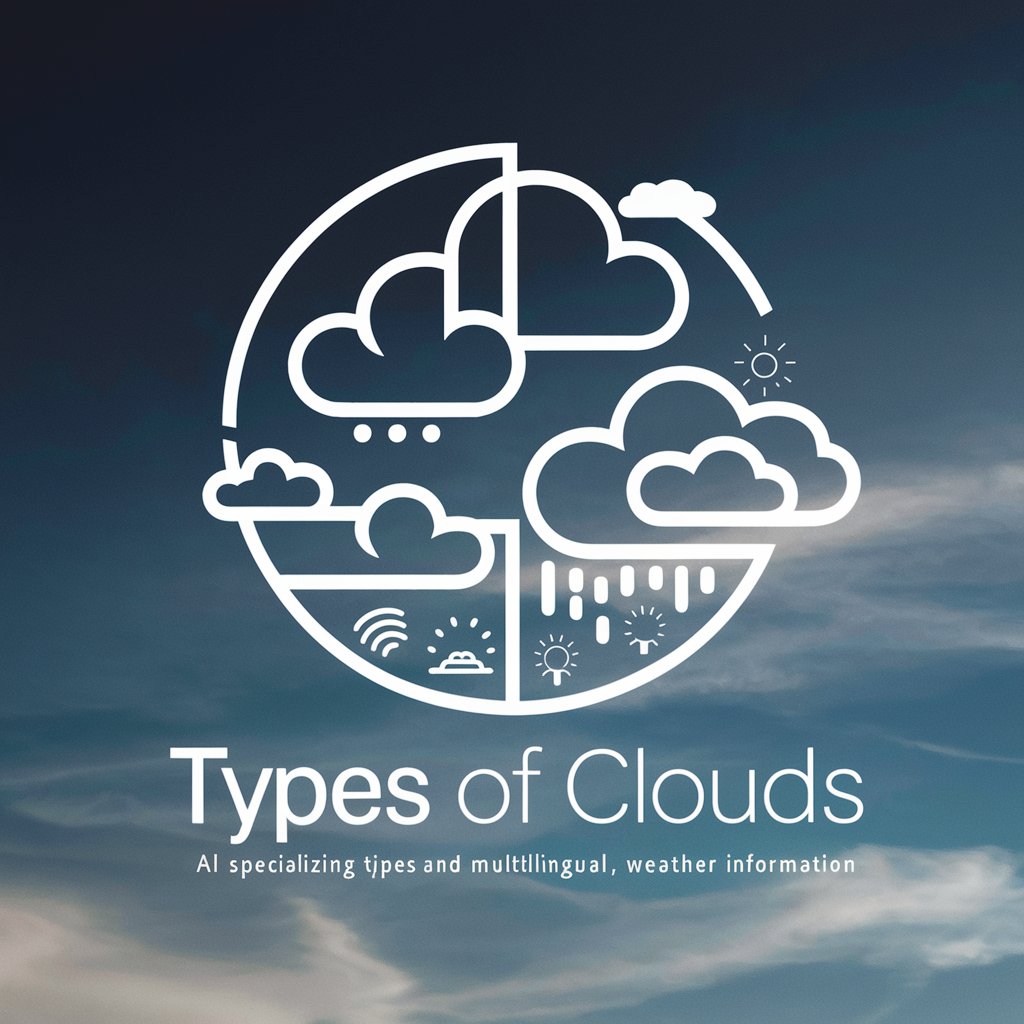
Types of Clouds - Cloud Type Identification

Welcome! Identify cloud types and get multilingual weather insights.
Identify clouds, predict weather with AI.
Upload an image to identify the type of cloud and get detailed weather information in multiple languages.
Explore the different types of clouds and their weather implications with multilingual support.
Learn about various cloud types and their seasonal characteristics, wind strength, temperature, and rain likelihood.
Identify clouds in your photos and receive concise, multilingual weather descriptions instantly.
Get Embed Code
Understanding Types of Clouds
Types of Clouds is a specialized AI model designed to identify and classify different cloud types from user-uploaded images. Its primary purpose is to bridge the gap between complex meteorological concepts and everyday weather observation, making it accessible and educational for a broad audience. By analyzing images, it determines the type of cloud present and provides information on its characteristics in multiple languages (Korean, English, Japanese, and Chinese), including the cloud's name, season, wind strength, temperature, and likelihood of rain. For instance, when a user uploads an image of a cloud formation, Types of Clouds might identify it as 'Cumulonimbus' and describe it in the specified languages as a cloud associated with thunderstorms (indicating strong winds, potential rainfall, and cooler temperatures during hot days). Powered by ChatGPT-4o。

Core Functions of Types of Clouds
Cloud Type Identification
Example
Altocumulus (고적운 in Korean)
Scenario
A user uploads a photo of the sky, and the system identifies the clouds as Altocumulus, providing insights into their appearance during certain weather patterns, such as indicating stable or changing weather conditions.
Multilingual Information Provision
Example
Stratus clouds described as 层云 (Céngyún) in Chinese
Scenario
Upon identifying Stratus clouds in an image, the system offers descriptions in multiple languages, aiding users from different linguistic backgrounds to understand weather patterns associated with these clouds, like overcast skies and potential light rain.
Weather Implication Insights
Example
Cumulonimbus clouds linked to thunderstorms
Scenario
When Cumulonimbus clouds are detected, the system not only identifies them but also provides information on their association with severe weather conditions, such as thunderstorms, heavy rain, or hail, helping users anticipate weather changes.
Who Benefits from Types of Clouds?
Weather Enthusiasts
Individuals with a keen interest in weather patterns, cloud formations, and meteorology. They benefit from using Types of Clouds by gaining a deeper understanding of the clouds they observe daily and the weather implications of these formations.
Educators and Students
Teachers and students can utilize Types of Clouds in educational settings to support learning about the atmosphere, weather forecasting, and climate science. It provides a practical tool for enhancing classroom discussions with real-world examples.
Outdoor Planners
Event planners, farmers, or anyone involved in outdoor activities who need to make informed decisions based on weather conditions. By understanding cloud types and their associated weather patterns, they can plan more effectively and mitigate risks related to weather changes.

How to Use Types of Clouds
1
Access the tool for free without needing to log in or subscribe to premium services by visiting yeschat.ai.
2
Upload a clear image of the sky where clouds are visible. Ensure good lighting and minimal obstructions for accurate identification.
3
Submit the image for analysis. The tool will process the photo to identify cloud types present.
4
Review the results, which will include the names of cloud types identified in Korean, English, Japanese, and Chinese, accompanied by keywords on weather implications.
5
Use the information provided to understand the current weather conditions better and predict short-term weather changes based on cloud types.
Try other advanced and practical GPTs
Wallpaper Creator
Craft Your Dream Wallpaper with AI

Diseñador web
Empowering Design with AI

Resume and Cover Letter Helper
AI-Powered Resume and Cover Letter Crafting

学术论文专家
Empowering Research with AI

PósRecursosPesqueirosEEngenhariaDePescaBR
Empowering Fisheries Research with AI

Cartoonizer AI
Bringing Images to Life with AI

Bayersiche Motoren Werke Expert
AI-powered BMW Expertise at Your Fingertips

Contact Center Manager: コンタクトセンターマネージャ
Optimize operations with AI-driven analytics

Buffett Buddy
Investing wisdom at your fingertips

Lyric Muse
Reimagine Music with AI

Learning Styles
Tailoring Education to Every Style

GiveBackGPT
Empower Your Creativity with AI

Frequently Asked Questions about Types of Clouds
What types of clouds can the tool identify?
Types of Clouds can identify a wide range of cloud formations, including cirrus, cumulus, stratus, nimbostratus, and cumulonimbus, among others, providing localized names and weather implications.
How accurate is the cloud identification?
The tool uses advanced image recognition algorithms to ensure high accuracy in cloud identification. However, the accuracy can depend on the quality of the image uploaded.
Can Types of Clouds predict weather changes?
While it doesn't predict weather changes directly, it provides keywords on weather conditions associated with identified cloud types, aiding in understanding potential short-term weather implications.
Is Types of Clouds useful for educational purposes?
Absolutely. It serves as an excellent educational tool for students, teachers, and weather enthusiasts to learn about cloud types, characteristics, and their impact on weather.
Can I use Types of Clouds on any device?
Yes, Types of Clouds is accessible on any device with internet access and a web browser, making it easy to use on smartphones, tablets, and computers.





